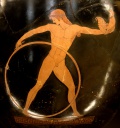Template:Portal:History:Ancient Greece: Difference between revisions
From BoyWiki
No edit summary |
|||
| Line 7: | Line 7: | ||
* [[Trochus/Hoop|The hoop]] held symbolic meanings in Ancient Greek myth and culture and was used to represent a boy or youth in general in Greek art. The Greeks referred to the hoop as the trochus or krikoi, and they were probably made of bronze, iron, or copper. | * [[Trochus/Hoop|The hoop]] held symbolic meanings in Ancient Greek myth and culture and was used to represent a boy or youth in general in Greek art. The Greeks referred to the hoop as the trochus or krikoi, and they were probably made of bronze, iron, or copper. | ||
*[[Hyacinth (mythology)|Hyacinth]] is a divine hero from Greek mythology and Apollo's young lover, a beardless youth between the ages of 12 and 19. | |||
|} | |} | ||
<noinclude> | <noinclude> | ||
[[Category:Templates portal history]] | [[Category:Templates portal history]] | ||
</noinclude> | </noinclude> | ||
Revision as of 13:01, 29 July 2014
| Ancient Greece |

|